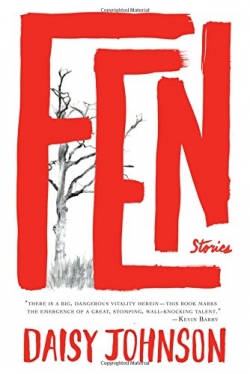Fen
by Daisy Johnson
reviewed by Chelsea Bingham
A primal, feminine power imbues familiar themes and experiences with transformative energy in Daisy Johnson’s debut collection, Fen. With stories set in the Fenlands of eastern England, Johnson uses elements of myth, legend, and folklore to capture the complexity of small, isolated (and isolating) communities. Concerned with family, friends, relationships, sustenance, and survival, this collection explores what it means to be a woman actively engaged with the world.
The first story, “Starver,” opens with writhing eels that live in the fen and refuse to eat after the water around them is drained away, an allusion to the creation of the fen as an agricultural region. This vignette gives way to a much more common plight as a girl describes her sister’s refusal to eat. Suze plies Katy with all kinds of food, leaving it where she “knew she would find it: on her bedside table, on the top of the cistern in the bathroom, in the drawers where she kept her clothes,” all the places one uses every day, though not, of course, where food belongs. Katy stuffs the food into the guttering outside her window, slowly starving herself into another being. From this self-immolation comes her freedom.
In “Blood Rites,” Greta, Arabella, and the narrator move from Paris to a rickety house along a fen canal, vowing never to “let our food ruin our lives.” Reminiscent of the Grayer twins in David Mitchell’s Slade House, these women seem to come from another time, costuming and caricaturing themselves in present fashion to lure in the prey they feed upon. Driven out of Paris because of their needs, they are still trapped by them when they begin a new life in the fen. Instead of the usual childhood remembrances, they recall, “When we were younger we learnt men the way other people learnt languages or the violin.” But the fen men produce unexpected side effects: “They lingered in you the way a bad smell did.”
Though often haunting and serious, this collection is full of sharp humor. The narrator in “How to Fuck a Man you Don’t Know” observes of one member of the male species:
He texts you song lyrics while you’re at work and often there are books he has bought you on the bed. You want to tell him you can buy your own books; that you do not want something everybody else is reading, that you are a snob without any taste but that your taste is better than that. You don’t.
And another:
There is a beautiful man in the corner you all think wears his clothes like skin; that isn’t the one you want to take home. Men like that know too well what they look like and will make you pay for it later.
And of herself:
You do not shave your legs or pubic hair. It is not a wedding night, not a parade or a party or an invitation. You are not a welcome mat.
Playing with the language men and women use to describe each other and themselves, the narrator covers a diverse range of heterosexual interactions and reactions that at times inverts typical gender roles and at others colludes with them.
Johnson revisits gender stereotypes and sexual relationships throughout the collection. In “Birthing Stones,” Emma waits for her date in a restaurant. He’s late, and she plays out what will happen when he shows up. A sitcom plot might first come to mind, but instead of over-the-top awkwardness, Emma remains unsettlingly calm, inviting the waiter over with her eyes and asking, “What do you think will make him most jealous?” when she decides to order. Interwoven is her origin story, a witchy immaculate conception that explains why she never leaves her fen village: “She was limbed to the ground. To that place, this town. Like a root. Planted in.” The potency of the place one comes from manifests literally in this story, though anyone from a small town or community will recognize the feeling.
In the final story, “The Lighthouse Keeper,” a woman comes across a fish she’s never seen before. She becomes obsessed with catching it, and one night after two bottles of wine, she notes that “It moved with an almost human intelligence. Not a food source or a pretty thing to watch but, maybe, a friend.” Johnson routinely parallels human characteristics and animal instinct, here bringing the collection full circle. The lighthouse keeper fears for the fish, watching as boats (manned by men) begin hunting it: “They would catch the fish: most of them drunk … Barely enough for a bite each and with the taste of marshes and fen earth, but more of a ritual than anything else, as potent as taking church bread onto your tongue.”
Johnson’s language venerates the subject with which she is most preoccupied: the female experience. Women aren’t objects in this collection. They may be pretty to watch, but they are dangerous, the driving force behind each of these memorable stories.
Published on June 27, 2017

